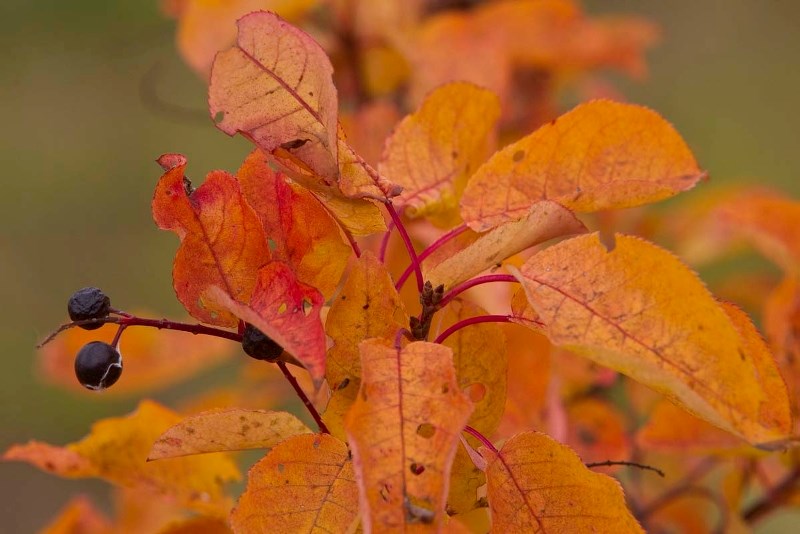I've noticed two big changes in the trees around the Gazette offices recently. First off, their leaves have turned from a grassy green to a golden yellow over the course of a few weeks, bringing some spectacular colouration to the landscape.
I've noticed two big changes in the trees around the Gazette offices recently.
First off, their leaves have turned from a grassy green to a golden yellow over the course of a few weeks, bringing some spectacular colouration to the landscape.
Secondly, the trees are now infested with ladybugs – big shiny six-spots and tiny crimson two-spots zip up and down the trunks on their tiny legs, gobbling up what looks like hordes of black aphids.
Turns out these two changes are connected. The turning of the leaves is just one part of a whole host of changes the natural world undergoes during the fall.
Researchers believe that leaves change colour due in most part to changes in the length of the day, says local retired forestry professor Peter Murphy. Temperature also appears to play a role.
It also depends on genes. A tree that was raised up in the north generally will stay green longer than one bred down south as it's better adapted to cold weather, says University of Alberta plant physiologist Janusz Zwiazek.
Give a tree consistent warmth and light in a greenhouse and it will stay green year-round, Zwiazek adds. Some will still stop growing in the winter, however.
Winter poses a threat to trees since water freezes and expands, and they're made mostly of water, Murphy explains. The thick, tough, waterproof leaves of coniferous trees can take it, but the thin leaves on deciduous trees cannot. If leaves freeze while still hooked to the tree, they act like rotten limbs that can let water out and disease in.
“The tree has to protect itself by cutting off that loss of nutrients,” Murphy says.
A layer of cells called the abscission layer forms at the base of the leaf to cut off its nutrients so it falls off, Murphy says.
Aphids can sense when this happens and use it as a signal to scatter and lay eggs, says Ieuan Evans, plant pathologist with Agri-Trend Agrology – that's why there are so many of them buzzing about right now. All those aphids look delicious to ladybugs, so you may see swarms of them on local trees as well.
Trees of many colours
Tree leaves contain many pigments that give them their colours. In the summer, the dominant one is chlorophyll, which performs photosynthesis and is green. Also present are carotenoids (the yellow and orange of corn and carrots) and anthocyanins (the red of apples and the blue of blueberries).
Different trees produce different amounts of these chemicals and turn different colours reports the U.S. Forest Service. Oaks and maples are red, poplars are yellow, and hickory is a sort of golden bronze.
While carotenoids are thought to aid in photosynthesis by absorbing different wavelengths, Zwiazek says researchers aren't sure why trees make anthocyanins. They might protect the tree from UV radiation, help store nitrogen, spook bugs, or even poison the soil to discourage other species from moving in, but no one's figured out their precise purpose.
When fall approaches, trees stop producing new chlorophyll and let their existing stock of it break down so they can recover precious minerals, Evans says. The green goes away, and the carotenoids and anthocyanins become visible, producing pretty colours. Were it not for these substances, tree leaves in fall would turn pale white, he notes.
The brilliance of a leaf's colour depends on the amount of moisture available, Evans says.
“In dry falls, they're much more colourful than in wet, cool falls,” he notes.
If a tree has lots of water and minerals, it can take the sugars made from photosynthesis and use them for growth, Evans says. Those sugars can't be used if it's dry out, so the tree turns them into colourful anthocyanin instead. The more brilliant a tree looks in the fall, the more anthocyanin it has in its leaves, and the worse its year has been in terms of growth.
Anthocyanin production tends to spike when a tree can't get sugars out of its leaves, the U.S. Forest Service notes – as happens during the cool nights of fall when the abscission layer is cutting leaves off from the tree. Warm, sunny days and cool nights tend to produce brighter reds as a result, but have little effect on yellows, as carotenoids are always present in leaves.
Colours are fairly ephemeral, Evans says, being organic substances that break down in sunlight.
“If you do get a nice, colourful leaf, press it immediately,” he says. Properly preserved and protected from light, a leaf can hold its colour for years.
